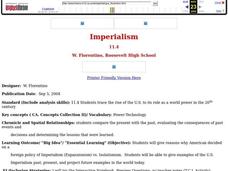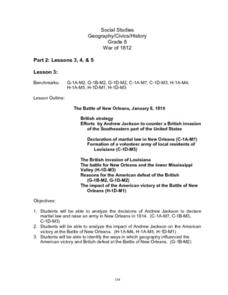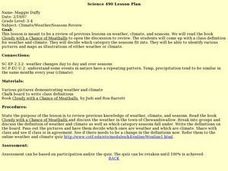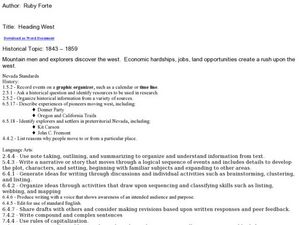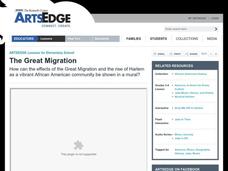Curated OER
Number the Stars, Lesson 11
Students analyze point of view in the novel Number the Stars. Their writing prompt is how would this chapter(11) be different if Peter were telling the story? Students create a class concept web about pride on the board.
Curated OER
Imperialism
Students explore the concept of Imperialism. In this foreign policy lesson, students examine the policies of the US and other countries through time. Students then create a political cartoon of their own and create a timeline that...
Curated OER
Whose Rights are Right?
Students consider the concept of 'human rights' in relation to the current conditions and history of East Timor and discuss the terms "human rights" and "force," applying their responses to specific historical examples.
Curated OER
Antebellum North Carolina
Eighth graders examine pictures & documents relating to the Hayes Plantation (Edenton, NC). They also use various maps of North Carolina to help them analyze how James Cathcart Johnston used, modified and adapted to the physical...
Curated OER
Santa Claus Around the World
Students investigate how students in various countries celebrate their winter holiday traditions, locate various countries on a map, and draw and tell about various Santa Claus legends.
Curated OER
Yo-ho, Yo-ho a Viking's Life for Me
Students complete a unit of lessons on the Vikings. They analyze maps, read and discuss myths, summarize the main ideas from resource materials, watch videos, sing a song, draw a picture to illustrate Norse mythology, and define key...
Curated OER
Conducting a Scientific Investigation
Students investigate a possible health problem in the local school district through inquiry into attendance records, activities, maps, graphs, and data tables. The simulation continues as solutions for the problem are sought.
Curated OER
Exploring California's Regions
Students participate in small groups to create a California's Region map. They research and identify the climate, geographic features, and one or two special features of their assigned region.
Curated OER
War of 1812
Eighth graders locate the major land forms and bodies of water on a map of Louisiana. In groups, they discuss the role of the Mississippi River in the Battle of New Orleans and how land and water affect the outcome of battles. To end...
Curated OER
Westward Ho!
Second graders use a minimum of three maps of Kansas developed during the 1800's. They plot five major settlements that developed near water sources. Students brainstorm reason settlements may have developed near water sources.
Curated OER
Aquifer Model
Students, after researching and brainstorming about aquifers and locating aquifer maps of Texas, participate in the building of a model of an aquifer complete with a pumping station. They also answer a variety of questions at the...
Curated OER
Climate Weather Seasons Review
Students review the concepts of weather, climate, and seasons. They read and discuss a book about weather. Students collaborate on a class definition for climate and weather. They match weather to the specific season. Students...
Curated OER
What Is a Watershed?
Learners explore the concept of water pollution. In this environmental stewardship lesson, students discover what watersheds are and consider how to protect them.
Curated OER
Heading West
Students study the concept of the westward expansion. In this exploration of the western U.S. lesson, students participate in different activities that explain economic hardships, jobs, and land opportunities. Students describe...
Curated OER
Confucius Say... China Old
Students locate China on the map. In this Chinese geography, history and culture lesson, students read literature about China. Students participate in paper making, silk making and lantern making activities.
Curated OER
Spelling Instant Activity
Sixth graders understand the usage of capital letters for mapping skills. In this capitalization lesson, 6th graders correct sentences to insert appropriate capital letters. Students select cities from the sentences and make a word puzzle.
Curated OER
Ingredients of a Mystery
Students explore the concept of mysteries. For this mystery genre lesson, students identify the common characteristics of mystery books and use a story map to identify these characteristics in a given book. Students also discover the...
Curated OER
Distribution of children living at home
Students use E-STAT to examine demographics. In this social demographics lesson, students use statistical data to determine if a particular family is in need of assistance. Students will discuss social and educational policies and...
Curated OER
The Great Migration
Students explore how migration to Harlem created a new life for African Americans. In this cross curricular lesson, students illustrate maps showing the migration, paint murals representing African American life in the South and create a...
Curated OER
The Open Ocean, What is it and How Does it Change?
Students investigate the ocean environment. In this ocean lesson, students discover the physical properties of the ocean. Over two days, students work in small groups investigating ocean maps and creating water currents.
Curated OER
Cloudy With A Chance of Meatballs
Second graders explore weather. In this weather lesson, 2nd graders read Cloudy With A Chance of Meatballs and participate in four supplemental science activities. Students participate in Internet research, create weather maps,...
Curated OER
Teaching The Personality Profile
Young scholars write a comprehensive personality profile feature that demonstrates knowledge of the Wall Street Journal formula of feature writing and the concept of show, don't tell. They experience a press conference interview situation.
Curated OER
Thematic Unit: Beginning Holocaust Studies
Fifth graders discuss concepts of diversity, culture, and prejudice, gain understanding of harm caused by prejudice, and demonstrate ability to think critically and a desire to act morally.
Curated OER
ABCs of Hydrogen and Fuel Cells
Young scholars are introduced to the concept of hydrogen technologies through inquiry-based classroom activities.



